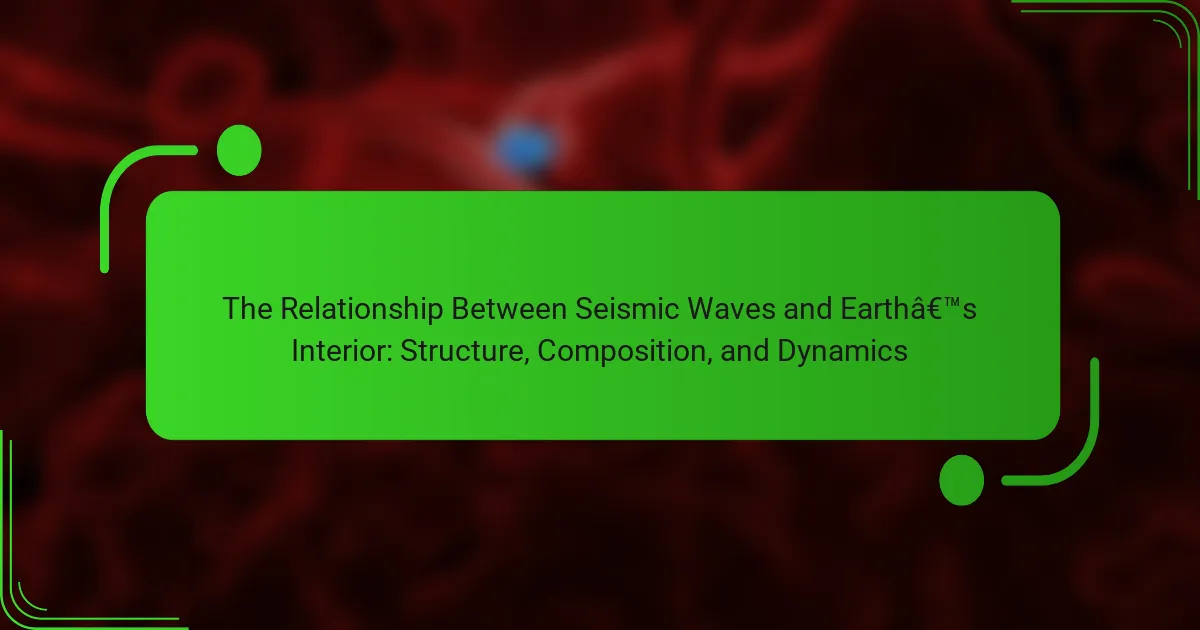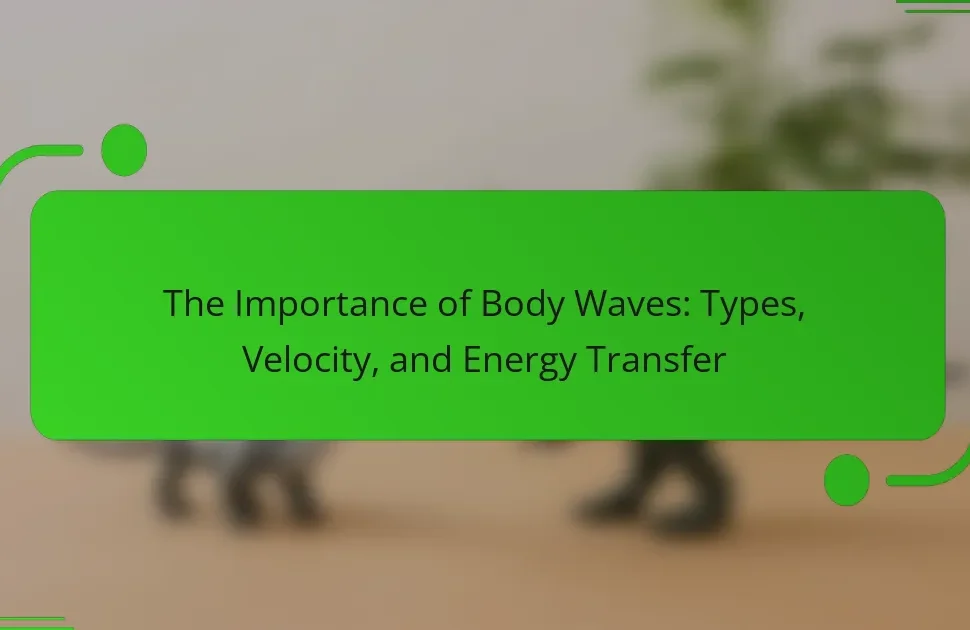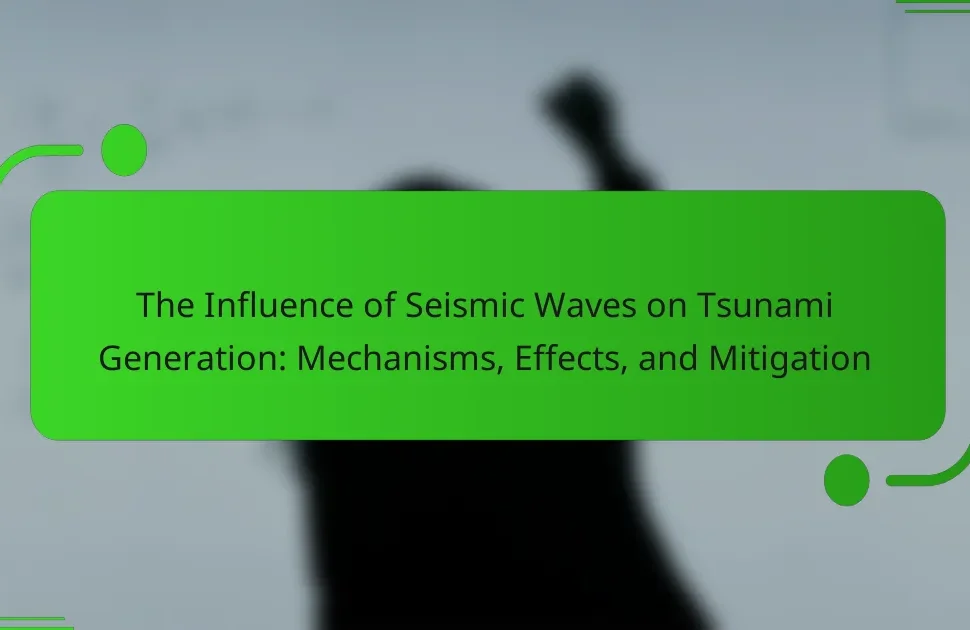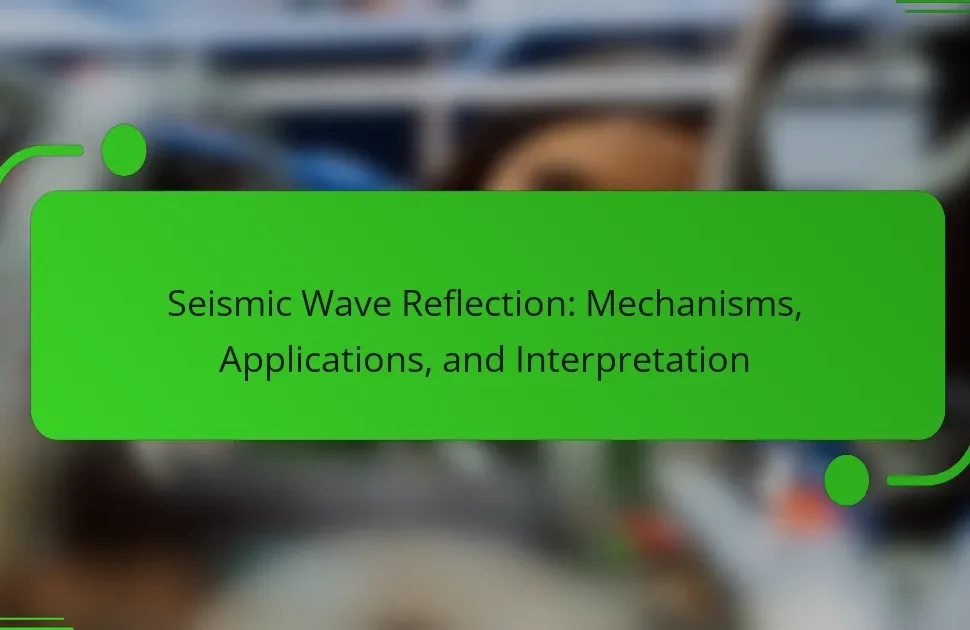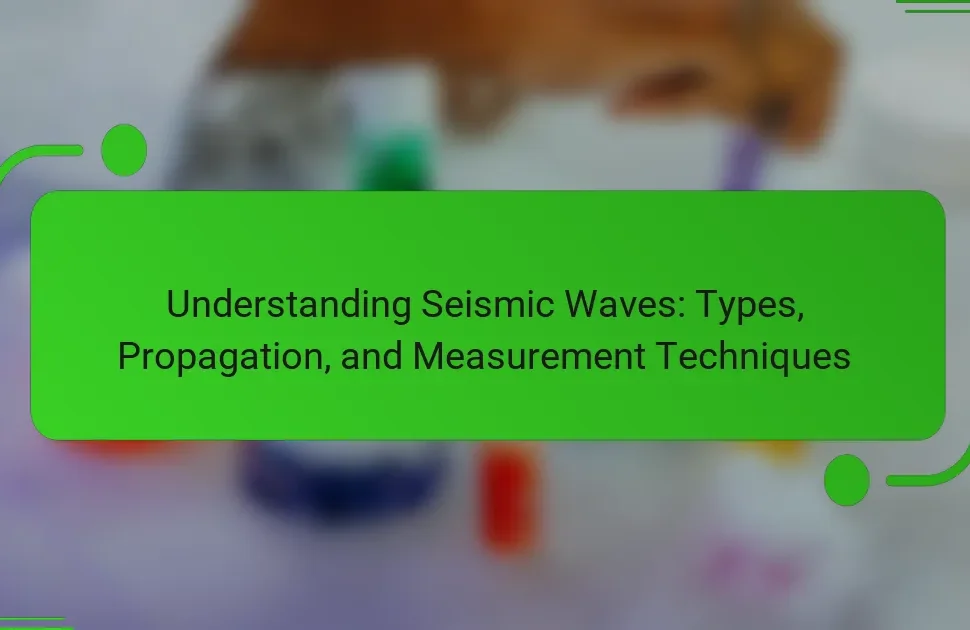Seismic waves are energy waves produced by geological events, such as earthquakes, that travel through the Earth and provide insights into its internal structure. There are two primary types of seismic waves: P-waves, which can move through both solids and liquids, and S-waves, which can only travel through solids. The propagation of these waves reveals the layered composition of the Earth, including the crust, mantle, outer core, and inner core, while their speed and behavior help scientists infer material properties and dynamics within these layers. By analyzing seismic wave patterns and data collected from seismic events, researchers can enhance their understanding of Earth’s geology and tectonic activity.

What are Seismic Waves and Their Role in Understanding Earth’s Interior?
Seismic waves are energy waves generated by geological events, such as earthquakes. They travel through the Earth and provide critical information about its internal structure. There are two primary types of seismic waves: P-waves (primary waves) and S-waves (secondary waves). P-waves are compressional waves that can travel through solids and liquids. S-waves are shear waves that only move through solids.
As seismic waves propagate, they change speed and direction when encountering different materials within the Earth. This behavior helps scientists infer the composition and state of Earth’s interior layers, such as the crust, mantle, and core. For example, the presence of a liquid outer core is inferred from the absence of S-waves in that region.
Seismology, the study of seismic waves, has revealed that the Earth’s interior is layered and composed of various materials. The speed and path of seismic waves are recorded using seismometers. Analysis of this data allows researchers to create models of Earth’s internal structure. These models enhance our understanding of tectonic activity and the dynamics of Earth’s geology.
How do seismic waves travel through the Earth?
Seismic waves travel through the Earth by moving through different layers, including the crust, mantle, and core. These waves are generated by seismic events like earthquakes. There are two main types of seismic waves: P-waves and S-waves. P-waves, or primary waves, are compressional waves that can travel through solids and liquids. S-waves, or secondary waves, are shear waves that can only move through solids.
As seismic waves propagate, their speed varies based on the material they encounter. For instance, P-waves travel faster than S-waves. The Earth’s interior is layered, which affects wave behavior. When seismic waves reach a boundary between layers, they can reflect or refract. This behavior helps scientists understand the Earth’s internal structure.
Seismographs detect these waves, allowing for the mapping of Earth’s interior. The study of seismic waves provides insights into the composition and dynamics of the Earth’s layers.
What are the different types of seismic waves?
There are two main types of seismic waves: body waves and surface waves. Body waves travel through the Earth’s interior. They are further divided into primary waves (P-waves) and secondary waves (S-waves). P-waves are compressional waves that move faster than S-waves. They can travel through solids, liquids, and gases. S-waves are shear waves that only travel through solids. Surface waves travel along the Earth’s surface. They typically cause more damage during earthquakes. Surface waves are slower than body waves. They include Love waves and Rayleigh waves. Love waves move horizontally, while Rayleigh waves move in an elliptical motion.
How do the properties of seismic waves change as they move through various layers of the Earth?
Seismic waves change properties as they move through various layers of the Earth. The primary types of seismic waves are P-waves (primary waves) and S-waves (secondary waves). P-waves travel faster than S-waves and can move through solids and liquids. In the Earth’s crust, seismic waves travel at speeds of about 5 to 6 km/s. As they enter the mantle, the speed increases to about 8 km/s due to higher density and elasticity.
In the outer core, P-waves continue to travel but S-waves are absorbed because the outer core is liquid. This results in a shadow zone where S-waves do not reach. In the inner core, seismic waves travel at speeds of approximately 11 km/s as they encounter solid iron. The change in density, temperature, and state of matter in these layers significantly affects wave speed and behavior. These variations provide crucial information about the Earth’s internal structure.
Why are seismic waves important for studying Earth’s structure?
Seismic waves are crucial for studying Earth’s structure because they provide insights into the planet’s internal composition and behavior. These waves travel through different layers of the Earth, allowing scientists to infer characteristics of materials they pass through. For instance, seismic waves change speed and direction when encountering varying densities and states of matter. This behavior helps delineate the boundary between the Earth’s crust, mantle, and core.
Moreover, seismic waves are used to create models of Earth’s interior, revealing its complex layering. The study of seismic wave propagation has led to significant discoveries, including the identification of liquid outer core and solid inner core. Historical seismic events, such as the 1906 San Francisco earthquake, have provided valuable data for understanding tectonic activity. Thus, seismic waves are fundamental tools for geologists and seismologists in mapping and interpreting Earth’s internal structure.
What information do seismic waves provide about the Earth’s interior composition?
Seismic waves provide critical information about the Earth’s interior composition. They help scientists understand the structure and properties of different layers within the Earth. Seismic waves travel at varying speeds depending on the materials they pass through. For example, P-waves, or primary waves, travel faster in solid materials than in liquids. This difference indicates that the outer core is liquid because S-waves do not travel through it.
The reflection and refraction of seismic waves reveal the boundaries between layers. These layers include the crust, mantle, outer core, and inner core. Each layer has distinct physical and chemical properties. By analyzing seismic wave patterns, geologists can infer the density and composition of these layers.
In summary, seismic waves are essential for mapping the Earth’s internal structure and understanding its composition. Their behavior provides insights into the materials that make up the Earth’s interior.
How do seismic waves help identify the boundaries between different layers of the Earth?
Seismic waves help identify the boundaries between different layers of the Earth by revealing variations in material properties. When seismic waves travel through the Earth, they change speed and direction at layer boundaries. This occurs due to differences in density and composition between layers such as the crust, mantle, and core.
For instance, seismic waves travel faster through solid materials than through liquids. This difference allows scientists to detect the transition from the solid mantle to the liquid outer core. Additionally, seismic waves reflect and refract at these boundaries. The analysis of these reflections and refractions provides detailed information about the Earth’s internal structure.
Seismologists use data from seismic wave recordings during earthquakes to map these boundaries. The patterns of wave travel times and paths help create models of the Earth’s interior. This method has confirmed the existence of distinct layers and their properties.
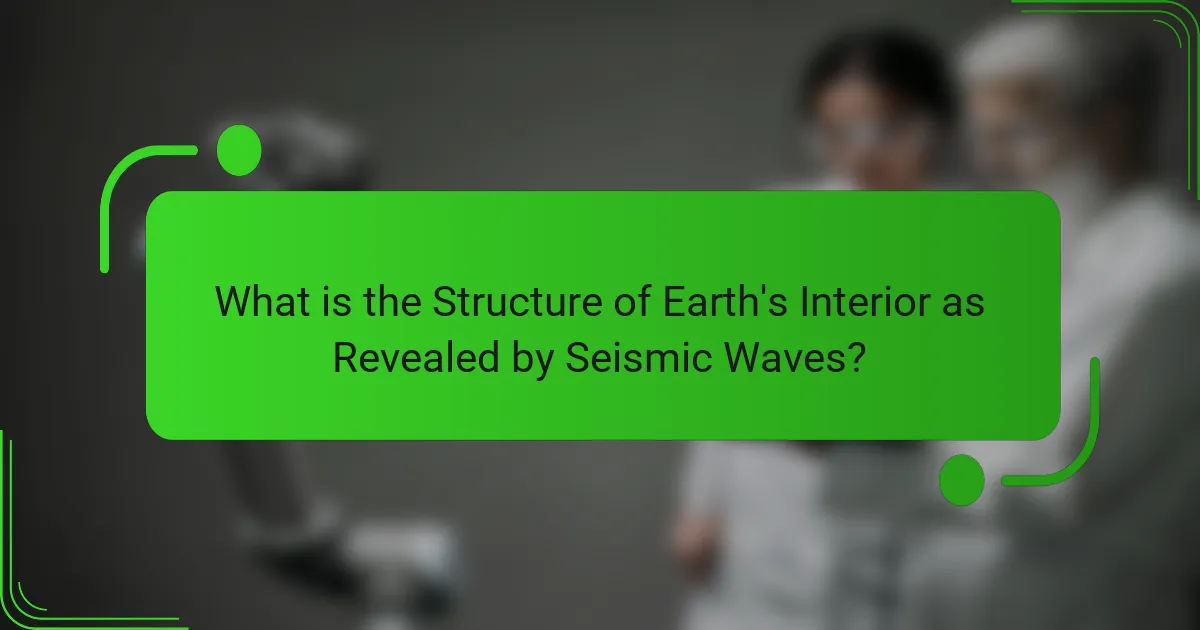
What is the Structure of Earth’s Interior as Revealed by Seismic Waves?
The structure of Earth’s interior, as revealed by seismic waves, consists of several distinct layers. These layers include the crust, mantle, outer core, and inner core. The crust is the outermost layer, varying in thickness from 5 to 70 kilometers. Below the crust lies the mantle, extending to about 2,900 kilometers deep. The mantle is composed of semi-solid rock that flows slowly over geological time.
Seismic waves travel at different speeds through these layers. P-waves, or primary waves, can move through solids and liquids, while S-waves, or secondary waves, can only travel through solids. This difference indicates that the outer core is liquid, as S-waves do not pass through it. The inner core, however, is solid due to immense pressure, despite its high temperatures.
Seismic data collected from earthquakes and artificial sources provide insights into these layers. By analyzing the speed and behavior of seismic waves, scientists have mapped the boundaries and compositions of Earth’s interior. This information confirms the layered structure of the Earth and helps understand its dynamics and composition.
What are the main layers of the Earth’s interior?
The main layers of the Earth’s interior are the crust, mantle, outer core, and inner core. The crust is the thin, solid outer layer where we live. Beneath the crust lies the mantle, which is semi-solid and extends to about 2,900 kilometers deep. The outer core is liquid and composed mainly of iron and nickel, located beneath the mantle. Finally, the inner core is solid and consists primarily of iron, with temperatures reaching up to 5,700 degrees Celsius. These layers are defined by their composition and physical state, which affect how seismic waves travel through the Earth.
How do seismic waves indicate the characteristics of the crust?
Seismic waves indicate the characteristics of the crust through their speed and behavior as they travel. The two main types of seismic waves are P-waves and S-waves. P-waves are compressional waves that travel faster than S-waves, which are shear waves. The speed of these waves varies depending on the material they pass through.
When seismic waves encounter different layers of the crust, their velocity changes. This change in speed helps scientists determine the density and composition of the crust. For instance, P-waves travel faster in denser materials. S-waves do not travel through liquids, which indicates the presence of molten rock or magma.
Seismographs record the arrival times of these waves. By analyzing the time difference between P-wave and S-wave arrivals, researchers can infer the depth and composition of crustal layers. This method has been validated by numerous seismic studies, enhancing our understanding of Earth’s structure.
What role do seismic waves play in understanding the mantle’s properties?
Seismic waves are crucial for understanding the mantle’s properties. They provide insights into the mantle’s composition, temperature, and physical state. Seismic waves travel at different speeds through various materials. This speed variation indicates changes in density and elasticity within the mantle. For instance, P-waves can pass through both solid and liquid, while S-waves only travel through solids. The absence of S-waves in certain areas suggests the presence of liquid layers. Studies have shown that seismic wave data can reveal the mantle’s structure down to depths of 2,900 kilometers. This information is vital for modeling Earth’s internal processes and understanding tectonic activity.
How do seismic waves reveal information about the Earth’s core?
Seismic waves reveal information about the Earth’s core by traveling through different layers of the Earth. These waves are generated by earthquakes or artificial sources. As seismic waves propagate, they encounter various materials with distinct properties. The speed and behavior of these waves change depending on the density and composition of the materials they pass through.
For example, seismic waves travel faster through solid materials than through liquids. This difference allows scientists to identify the solid inner core and the liquid outer core of the Earth. Additionally, seismic waves can be reflected or refracted at boundaries between layers. This behavior provides insights into the structure and composition of the Earth’s interior.
Studies of seismic waves have shown that the outer core is liquid due to the slower wave speeds recorded in that region. In contrast, the inner core is solid, as indicated by the faster wave speeds. This information has been crucial for understanding the Earth’s formation and dynamics.
What are the boundaries between Earth’s layers?
The boundaries between Earth’s layers are known as discontinuities. These include the Mohorovičić discontinuity, the Lithosphere-Asthenosphere boundary, the Upper-Mantle-Lower-Mantle boundary, and the Core-Mantle boundary. The Mohorovičić discontinuity separates the Earth’s crust from the underlying mantle. The Lithosphere-Asthenosphere boundary distinguishes the rigid lithosphere from the more ductile asthenosphere. The Upper-Mantle-Lower-Mantle boundary marks the transition between these two mantle regions. The Core-Mantle boundary separates the mantle from the outer core. These boundaries are defined by changes in composition and physical properties. Seismic waves help identify these boundaries by exhibiting different velocities and behaviors as they pass through different layers.
How do seismic waves behave at the Mohorovičić discontinuity?
Seismic waves change behavior at the Mohorovičić discontinuity, commonly known as the Moho. When seismic waves reach the Moho, they experience a significant increase in velocity. This change is due to the transition from the less dense rocks of the Earth’s crust to the denser rocks of the mantle.
P-waves, or primary waves, travel faster than S-waves, or secondary waves. At the Moho, P-waves can exceed speeds of 7 km/s, while S-waves are unable to propagate through the liquid outer core beneath the Moho. This results in a reflection of seismic waves at the Moho, creating a distinct boundary detectable by seismographs.
The behavior of seismic waves at the Moho is crucial for understanding Earth’s internal structure. It provides insights into the composition and state of materials in the Earth’s crust and upper mantle.
What insights do seismic waves provide about the outer and inner core boundaries?
Seismic waves provide critical insights into the boundaries of the outer and inner core. They reveal the transition between the liquid outer core and the solid inner core. P-waves, or primary waves, can travel through both solid and liquid. Their behavior indicates that the outer core is liquid since they are refracted at the outer core boundary. S-waves, or secondary waves, cannot travel through liquids. Their absence in the outer core region confirms its liquid state. The inner core boundary is identified by the return of S-wave activity, indicating a solid state. This behavior of seismic waves helps geoscientists understand the Earth’s internal structure and composition.

How do Seismic Waves Inform Us About Earth’s Composition and Dynamics?
Seismic waves inform us about Earth’s composition and dynamics by providing data on how these waves travel through different materials. When seismic waves propagate, they travel at varying speeds depending on the density and elasticity of the materials they encounter. For example, P-waves, or primary waves, are faster and can move through solids and liquids, while S-waves, or secondary waves, only travel through solids.
The behavior of these waves reveals the structure of Earth’s interior. Scientists analyze seismic wave patterns to identify boundaries between layers, such as the crust, mantle, and core. The reflection and refraction of seismic waves indicate changes in material properties at these boundaries.
Additionally, the presence of seismic wave shadow zones suggests the liquid outer core’s existence, as S-waves do not reach these areas. This information helps geologists understand the composition of Earth’s layers. Overall, seismic waves serve as a critical tool in revealing the dynamic processes occurring within the Earth, including tectonic activity and mantle convection.
What are the key compositional elements of Earth’s layers identified through seismic data?
The key compositional elements of Earth’s layers identified through seismic data include the crust, mantle, outer core, and inner core. The crust is primarily composed of silicate rocks. The mantle consists of silicate minerals rich in magnesium and iron. The outer core is liquid and made mainly of iron and nickel. The inner core is solid, composed predominantly of iron and some nickel. Seismic waves travel at different speeds through these layers, allowing scientists to infer their composition. For instance, the transition between the crust and mantle is marked by the Mohorovičić discontinuity, where seismic waves accelerate significantly. This variation in wave speed is crucial for understanding the Earth’s internal structure.
How do seismic waves help in determining the mineral composition of the mantle?
Seismic waves help determine the mineral composition of the mantle by analyzing their speed and behavior as they travel through different materials. These waves change velocity based on the density and elasticity of the minerals they pass through. P-waves, or primary waves, can travel through both liquid and solid, while S-waves, or secondary waves, only travel through solids. The absence of S-waves in certain areas indicates the presence of liquid materials, like the outer core. By measuring the travel times of these waves, scientists can infer the composition and state of the mantle. For instance, faster seismic waves suggest denser, more rigid materials, while slower waves indicate less dense, potentially molten or partially molten regions. This method has been validated through various studies, including those utilizing global seismic networks and tomographic imaging techniques.
What unique attributes of the core can be inferred from seismic wave behavior?
The unique attributes of the Earth’s core inferred from seismic wave behavior include its composition and state. Seismic waves travel at different speeds through various materials. Primary waves (P-waves) can travel through solids and liquids, while secondary waves (S-waves) can only travel through solids. The absence of S-waves in certain areas indicates the outer core is liquid. The speed of P-waves increases significantly when they pass through the inner core, suggesting it is solid. These observations confirm that the outer core is composed mainly of molten iron and nickel, while the inner core is solid.
How do seismic waves contribute to our understanding of Earth’s dynamic processes?
Seismic waves contribute to our understanding of Earth’s dynamic processes by providing insights into the planet’s internal structure. These waves travel through different layers of the Earth, revealing variations in composition and state. For instance, seismic waves travel faster through solid materials than through liquids. This characteristic allows scientists to identify the solid inner core and the liquid outer core of the Earth.
Additionally, the behavior of seismic waves during earthquakes helps scientists map tectonic plate boundaries. The study of wave propagation informs us about fault lines and potential seismic hazards. Research from the United States Geological Survey (USGS) highlights that seismic tomography uses these waves to create 3D models of the Earth’s interior. These models illustrate how heat and material move within the Earth, influencing volcanic activity and plate tectonics.
Thus, seismic waves are crucial for understanding geological processes and the dynamic nature of our planet.
What role do seismic waves play in monitoring tectonic activity?
Seismic waves are crucial for monitoring tectonic activity. They provide real-time data about the Earth’s interior. When tectonic plates move, they generate seismic waves. These waves travel through the Earth and can be detected by seismographs. The speed and path of seismic waves indicate the type of materials they pass through. This helps scientists identify fault lines and areas of potential earthquakes. Studies show that analyzing seismic wave patterns can predict seismic events. For example, the 2011 Tōhoku earthquake was monitored using seismic wave data. This data allowed for better understanding of tectonic shifts and their impacts.
How can seismic data be used to predict earthquakes?
Seismic data can be used to predict earthquakes by analyzing patterns and anomalies in seismic wave activity. Scientists monitor seismic waves generated by both natural and artificial sources. They identify changes in wave speed and frequency that may indicate stress accumulation in geological faults. Historical data shows that these changes often precede significant seismic events. For example, the 1994 Northridge earthquake in California was preceded by unusual seismic activity. This data helps researchers develop models to forecast potential earthquake locations and magnitudes. By improving detection methods, scientists can enhance early warning systems for communities at risk.
What practical applications arise from understanding seismic waves and Earth’s interior?
Understanding seismic waves and Earth’s interior has several practical applications. One significant application is earthquake engineering. Engineers use seismic data to design buildings that can withstand seismic forces. This reduces the risk of structural failure during earthquakes.
Another application is resource exploration. Seismic waves help locate oil, gas, and mineral deposits. This technique improves efficiency in resource extraction.
Seismology also aids in volcanic activity monitoring. Understanding seismic waves can predict eruptions and mitigate hazards.
Additionally, seismic studies contribute to understanding climate change. They provide insights into geological processes affecting carbon storage.
These applications demonstrate the importance of seismic wave analysis for safety, resource management, and environmental studies.
How can knowledge of seismic waves aid in resource exploration?
Knowledge of seismic waves aids in resource exploration by providing insights into the Earth’s subsurface structures. Seismic waves travel through different materials at varying speeds. This variation helps geologists identify the composition and characteristics of rock layers. For instance, the presence of oil, gas, or minerals can be inferred from the seismic response of these layers. Techniques like seismic reflection and refraction are commonly used to map geological formations. These methods have proven effective in locating hydrocarbon reserves. Historical data shows that seismic surveys have led to significant discoveries in oil fields. In summary, understanding seismic waves enhances the ability to locate and assess natural resources beneath the Earth’s surface.
What are the implications of seismic studies for civil engineering and infrastructure development?
Seismic studies significantly impact civil engineering and infrastructure development. They provide essential data on ground motion and soil behavior during earthquakes. This information helps engineers design structures that can withstand seismic forces. For instance, buildings in earthquake-prone areas must meet specific codes to ensure safety. Seismic studies also inform the selection of construction materials and techniques. They guide the assessment of site conditions, influencing foundation design. Furthermore, these studies contribute to risk mitigation strategies for urban planning. By understanding seismic hazards, infrastructure can be better protected. Ultimately, seismic studies enhance the resilience of communities against natural disasters.
The main entity of the article is seismic waves, which are energy waves generated by geological events that travel through the Earth, providing critical insights into its internal structure and composition. The article explores the types of seismic waves, including P-waves and S-waves, and their roles in revealing the layered structure of the Earth’s crust, mantle, outer core, and inner core. It discusses how seismic waves change speed and direction when encountering different materials, allowing scientists to infer the characteristics of Earth’s layers and understand dynamic processes such as tectonic activity and resource exploration. Additionally, the article highlights the practical applications of seismic studies in civil engineering, infrastructure development, and monitoring volcanic activity.
